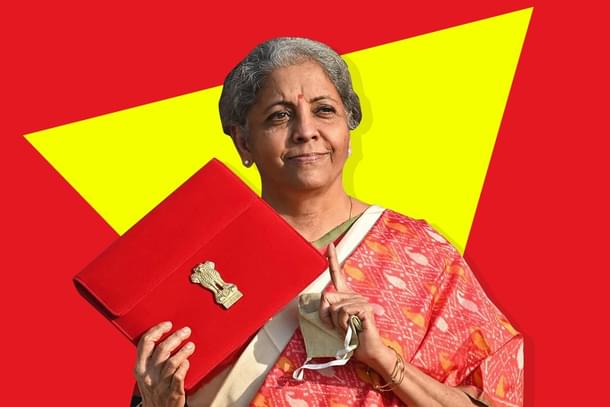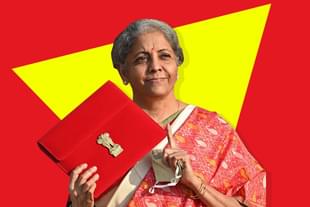Economy
Budget 2024-25: How It Fared On The 2047 Viksit Bharat Vision
TV Mohandas Pai and Nisha Holla
Jul 27, 2024, 12:38 PM | Updated 01:24 PM IST
Save & read from anywhere!
Bookmark stories for easy access on any device or the Swarajya app.


The Government of India has envisioned the country as Viksit or developed by 2047 and is working towards identifying the focus areas towards this vision. It is a commendable goal and helps align all stakeholders.
While working on a lofty 25-year vision such as Viksit Bharat 2047, it is essential to break down goals into short-term, medium-term, and long-term. While the government has done a remarkable job breaking down the goals and creating the pillars for the vision, the budget allocations seem to focus more on the short-term than the medium- and long-term.
The authors had published a series of articles prior to the budget highlighting some of these focus areas, which are analysed below in light of budget allocations — the first two being short-term in nature and the others with a much longer view of world leadership.
Women Empowerment
Budget 2024-25 allocated Rs 3 trillion for women-led development, focusing on increasing participation in the workforce via the setting up of working women hostels and creches in collaboration with industry, women-specific skilling programmes, and market access for women SHGs (self-help groups).
Programmes that have yielded great success in maternal and child healthcare continue to be supported. The doubling of the upper limit of Mudra loans to Rs 20 lakh will greatly help women entrepreneurs in the MSME (micro, small, and medium enterprises) sector who urgently require formal credit solutions.
The budget could have done more to respond to rural women, who are in dire need of direct cash support. Rural agricultural incomes are not growing to support aspirations, and the 2024 election highlighted the appeal of DBT (direct benefit transfer) and cash transfers to rural women who, above all, need increased purchasing power.
A DBT programme for rural BPL (below poverty line) women (about 10 crore) receiving subsidised LPG (liquefied petroleum gas) cylinders under PMUY (Pradhan Mantri Ujjwala Yojana) would have been ideal to respond to this category of citizens. If each were to receive Rs 2,000 monthly, totaling Rs 24,000 annually, it would cost the government Rs 240,000 crore for a year.
Middle-Class Taxpayers
The middle class, pivotal to India's tax collections, employment, and consumption, required relief, especially those 55+ who face high inflation without benefiting from existing tax breaks.
Budget 2024-25 announced a five-slab structure, which could have been simplified to three slabs with no returns on income up to Rs 5 lakh (L). The new rearrangement with the tax slabs is still complex, and the middle class may find the benefits minimal due to higher taxation offsetting gains.
To provide relief, a simpler tax structure could have been proposed as follows:
0-5L: 0 per cent
5-10L: 10 per cent
10-15L: 20 per cent
15L+: 30 per cent (with a 12 per cent surcharge above 15L)
Only deductions for insurance (80D) and philanthropy (80G) would remain, removing all others. This rearrangement can be provided as an alternative option along with one already available option with many deductions. Further, for senior citizens, a higher exemption limit could have been proposed.
The increase in capital gains tax on equity investments is another blow for the middle class. India’s stock market growth and retail investments have been one of the most encouraging vectors over the last decade, and the increase in LTCG may deter this growth. Stopping the indexation benefit on certain assets was unnecessary. Instead, the government should have indexed assets until 1 April 2024. This move can change the sentiment towards the budget, which is negative for the middle class.
Employment
The government is focused on creating 'well-paying jobs', with a target to provide employment and skill training to 4.1 crore youth.
The increased education budget is a strategic move, and the emphasis on agricultural research aims to boost productivity. Notably, the government’s employment-linked incentive programme will cover the employer’s share of the Provident Fund and the first month's wage, up to Rs 15,000, for new EPFO-registered employees.
Additionally, new schemes are supporting employment in manufacturing, and increased funding for women in the workforce and a 3 per cent subvention on education loan interest are steps towards inclusive growth. An internship programme will offer one crore youth exposure to the top 500 companies, linking education with employment.
Budget 2024-25 has certainly taken some strategic steps towards ensuring India’s large youth base, its demographic dividend, can access quality employment and easing employers’ friction in providing it.
However, the budget does not address India’s largest problem in employment, which is that jobs-creating industries are not located close to labour-surplus regions and districts. India's large aspirational class, especially those transitioning from agriculture, faces the critical challenge of high-quality job creation, particularly in the heartlands.
It will be prudent for India to establish Special Employment Zones (SEZs) in regions with surplus labour, targeting 300 backward districts and 1,000 tier 2/3/4 towns, ensuring connectivity for workforce commuting and goods movement. Entrepreneurs setting up industries in the SEZs can be further incentivised by giving grants of Rs 2,000 per month per new employee for the first 12 months and Rs 1,500 per month for the next 12 months. This would offset initial training costs and low productivity.
Tax deductions can also be offered to entities registering in these SEZs. The Kaushal scheme could be integrated for skilling and verification of salaries via EPF (employees' provident fund) or ESI (employees' state insurance) payments. Women, who may face commuting or relocation challenges, could find suitable local employment, significantly increasing their workforce participation.
The SEZ mission will promote large-scale job creation in India’s heartland, enabling backward districts to outpace state growth and become the nation’s new growth engines. The government must be more aggressive on this front.
Urban Development
It is refreshing to see the government make urban development a priority by targeting Rs 10 trillion in investment.
In particular, the focus on alleviating mobility concerns in the 14 largest cities via a transit-oriented development approach is promising, as these cities are overwhelmed by immigration and lack of development budgets to scale their mobility needs. Water supply, sewage treatment, and solid waste management are also significant concerns in these cities, which the budget is supporting.
Apart from this, measures addressing the housing needs of the urban poor, brownfield redevelopment, and orderly development of peri-urban areas are also encouraging.
As with the employment measures, however, the budget does not address the problem that people are migrating in droves from rural areas to the few urban agglomerates across India.
Alongside SEZs, India must develop a 5,000-town network with planned urbanisation to absorb the rural population seeking high-growth opportunities. Identifying 5,000 census towns across India, each will need Rs 100 crore annually for development over at least 10 years, with the Centre providing Rs 50 crore and the states the balance. Central funding will motivate states to allocate budgets.
The annual budget for these towns will be Rs 5 trillion, with an additional Rs 2.5-3 trillion for advanced mobility, water supply with six-month storage, sewage treatment, and power.
If some of the current allocations under Budget 2024 and other existing development schemes can be redirected towards a planned urbanisation scheme to develop this 5,000-town network, the government will spearhead the development of India’s new growth engine.
India’s top 20 cities need special attention as they are overwhelmed by immigration and underfunded. They require special grants from the Centre for infrastructure development, including roads, sewage treatment, water reservoirs, lakes, housing, and public transportation. The current metro coverage of 1,700 kilometres (km) must extend to 5,000 km sanctioned by 2030 between the 20 cities.
Central funding of at least Rs 1 trillion annually for the next 10 years is essential for these 20 cities. This can perhaps be pursued via the imminent 16th Finance Commission. Additionally, cities need greater tax devolution and should be permitted to raise municipal bonds in domestic and global markets to finance development.
Technology and Research Funding
Budget 2024-25 focused on research in a few key areas like agriculture, space, and nuclear energy, which is encouraging. The announcement of the “Anusandhan Fund” with Rs 1 trillion worth of financing pool with interest-free loans is interesting and could make a significant impact, provided the terms of the loans are liberally structured, include the private sector, and are managed by an independent committee.
However, there is a need for broad-based technology development, which the government must focus on. India’s vision of Top 3 economic leadership will require heavy investment in research, innovation, and technology and IP (intellectual property) development. The National Research Foundation (NRF) still lacks substantial allocations to date. It is also necessary to structure the terms and conditions of the NRF grants liberally, like the National Science Foundation in the United States (US), instead of being too rigid, which stifles innovation.
Budget 2024-25 also lacked the launch of new fund-of-funds for the startup sector, besides the Rs 1,000 crore space fund, which could have benefited from a much larger allocation.
The Indian startup ecosystem is recognised globally as a fast-growing sector attracting substantial foreign allocations — 85 per cent of the inbound capital into the ecosystem is from overseas. The government must catalyse domestic investments to balance this and enable India to invest in its own growth. The abolishment of the Angel Tax is the budget’s one significant move in this direction and has been appreciated by the whole ecosystem. Now funding must follow.
TV Mohandas Pai is Chairman, 3one4 Capital, and Nisha Holla is Research Fellow, 3one4 Capital





